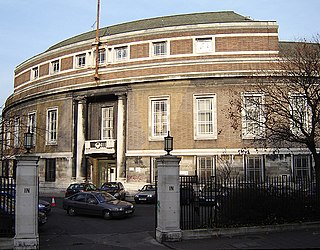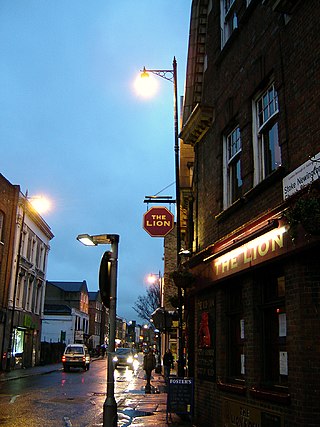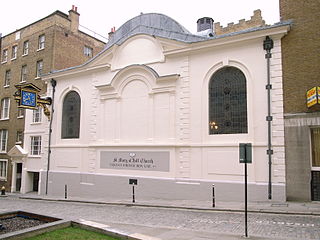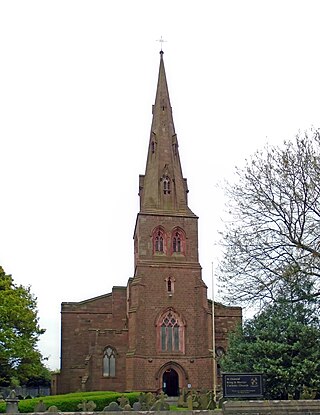
Stoke Newington is an area occupying the northwest part of the London Borough of Hackney, England. The area is five miles northeast of Charing Cross. The Manor of Stoke Newington gave its name to Stoke Newington the ancient parish.

Sir George Gilbert Scott, largely known as Sir Gilbert Scott, was a prolific English Gothic Revival architect, chiefly associated with the design, building and renovation of churches and cathedrals, although he started his career as a leading designer of workhouses. Over 800 buildings were designed or altered by him.

The Metropolitan Borough of Stoke Newington was a metropolitan borough in the County of London between 1900 and 1965 when it became part of the London Borough of Hackney.
John Oldrid Scott was a British architect.

Cowden is a small village and civil parish in the Sevenoaks District of Kent, England. The parish is located on the northern slopes of the Weald, south-west of Tonbridge, and lies close to the borders of both East Sussex and Surrey. It is situated within the High Weald AONB. The old High Street has Grade II listed cottages and village houses, and there is an inn called The Fountain. At the 2011 Census the population of the village was 818.
Stoke Newington was an ancient parish in the county of Middlesex. It was both a civil parish, used for administrative purposes, and an ecclesiastical parish of the Church of England.

Hackney was a parish in the historic county of Middlesex. The parish church of St John-at-Hackney was built in 1789, replacing the nearby former 16th-century parish church dedicated to St Augustine. The original tower of that church was retained to hold the bells until the new church could be strengthened; the bells were finally removed to the new St John's in 1854. See details of other, more modern, churches within the original parish boundaries below.

Stoke Newington Church Street is a road in north London of the borough of Hackney. The road links Green Lanes (A105) in the west to Stoke Newington High Street, in the east. Stoke Newington is one of the villages swallowed by the growth of London in the 19th century, and Church Street retains some of this neighbourhood feel, with many restaurants, pubs, and independent (non-chain) shops.

St George's Cathedral is an Antiochian Orthodox church in Albany Street, St Pancras, in the London Borough of Camden. Built to the designs of James Pennethorne, it was consecrated as an Anglican place of worship called Christ Church in 1837. It became an Orthodox cathedral in 1989.

St Mary-at-Hill is a Church of England parish church in the Ward of Billingsgate, City of London. It is situated on Lovat Lane, a cobbled street off Eastcheap.

St Matthias' Church is a Grade-I listed Church of England parish church in Stoke Newington, north London, England. Since it opened it has been known for its distinctly ‘High Church’ forms of worship.

St Mary Abbots is a church located on Kensington High Street and the corner of Kensington Church Street in London W8.

St Oswald's Church is a Roman Catholic parish church in St Oswald's Street, Old Swan, Liverpool, Merseyside, England. It is an active parish church in the Archdiocese of Liverpool and in St Joseph's Pastoral Area. The church is recorded in the National Heritage List for England as a designated Grade II listed building.

St Andrew, Stoke Newington, is a Grade II* listed Anglican parish church on Bethune Road in Stamford Hill, in the London Borough of Hackney, England. The church, which is dedicated to St Andrew, is located at the junction of Bethune Road and Dunsmure Road in London N16.

St Edmund's Church is the Roman Catholic parish church of Godalming, a town in the English county of Surrey. It was built in 1906 to the design of Frederick Walters and is a Grade II listed building. The church stands on a "dramatic hillside site" on the corner of Croft Road just off Flambard Way close to the centre of the town.

St Mary-at-Finchley Church is the Church of England parish church for Finchley. It is located in Hendon Lane, in the town centre, near Finchley Library.

The Rose and Crown is a Grade II listed public house at 199 Stoke Newington Church Street, Stoke Newington, Hackney, London, N16 9ES.

The Old Church is an arts venue in Stoke Newington, London Borough of Hackney, formerly the medieval and Tudor church of St Mary's Church or St Mary's Old Church. It is a Grade II* listed building.

Edvin Loach and Saltmarshe is a civil parish in north-east Herefordshire, England, and is approximately 15 miles (24 km) north-east from the city and county town of Hereford. The nearest town is Bromyard, 2.5 miles (4 km) to the south-west. Within the parish is a George Gilbert Scott built parish church in the virtually depopulated settlement of Edvin Loach, and the repurposed site of the demolished Saltmarshe Castle.

St Giles' Church is an active parish church in the village of Stoke Poges, Buckinghamshire, England. A Grade I listed building, it stands in the grounds of Stoke Park, a late-Georgian mansion built by John Penn. It is famous as the apparent inspiration for Thomas Gray's poem Elegy Written in a Country Churchyard; Gray is buried in the churchyard.

















